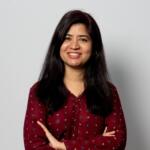Hyper-Personalization in Retail and its Benefits
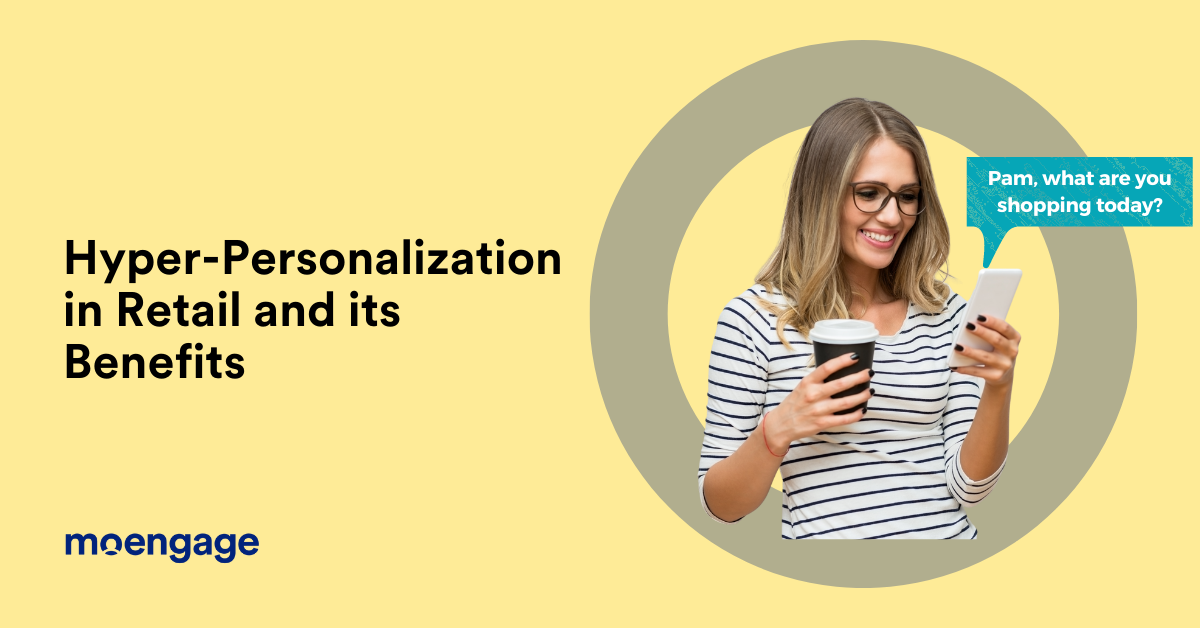
Reading Time: 9 minutes
Who doesn’t love personalized retail experiences? It started with your local mom-and-pop store understanding your preferences and needs and recommending products to you. The same level of offline retail personalization is now seen in E-commerce websites that recommend products based on recent purchases.
Now, brands are focusing on hyper-personalization in retail. They are evolving from just providing a siloed experience inside a store or online to an amalgamation of both.
Needless to say, whether it is a brick-and-mortar shop or an E-commerce website, hyper-personalization always adds value to the customer experience.
This is something that marketers have recognized and acknowledged. A case in point is – according to The State of Insights-Led Engagement Report, ~21% of consumer brands globally deploy a multichannel customer engagement platform, and ~18% use a marketing automation platform to drive superior customer experience.
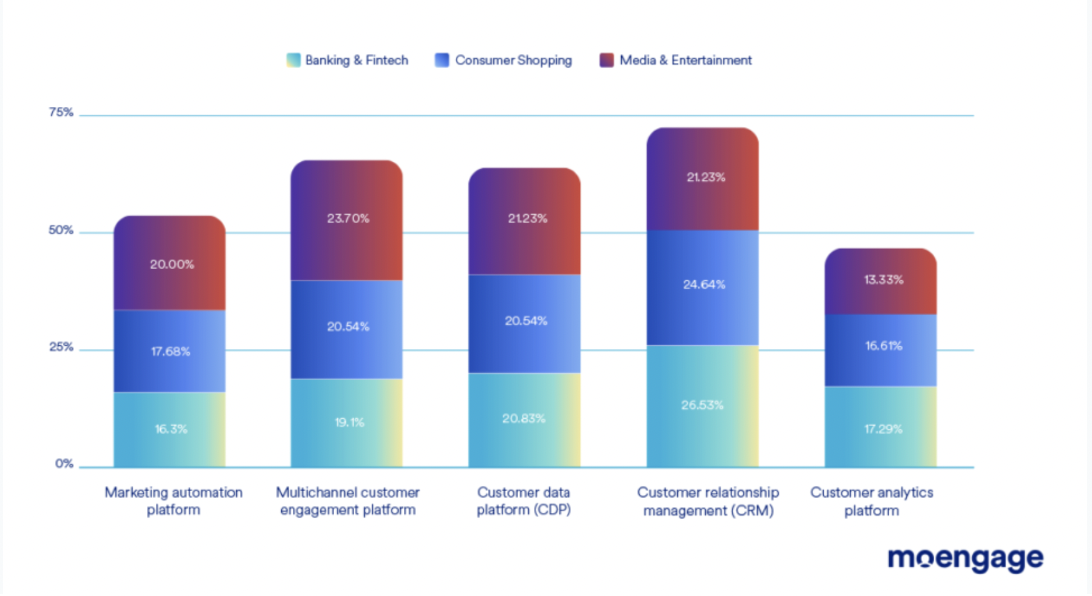
But before we look at the HOW and WHY of hyper-personalization, let us briefly understand the WHAT of hyper-personalization.
Hyper-Personalization in Retail
Hyper-Personalization basically is taking a step further from using just the name and search history of a customer. Instead, it is an art of gathering behavioral and real-time data of customers (such as browsing behavior, in-app behavior, use of devices, engagement data, purchase data, searches, and shopping carts)
As a retailer, you have to think of more ways to personalize the experience. Take the example of Lively experience store in New York. The moment you step into the store, you are handed over a beverage, and a salesperson takes your measurement and guides you with the shopping. The experience does not end there.
The store’s ambiance is deeply personal, complete with greenery and lounge chairs that give clubhouse vibes. And it’s not just the brick-and-mortar shops that got their personalization right.
Sephora has got both the in-store and online customer experience strategies right. Customers use the Sephora app to book a consultation appointment in the nearest store. They can also use the app to search for the products they had virtually sampled to check if it’s available in the store.
They have a successful loyalty program that has enabled them to gain over 25 million members! It’s an example of how you can stitch offline and online channels to create a seamless experience for your customers.
Brands today are also leveraging the power of technology to drive retail personalization. With the proliferation of artificial intelligence, machine learning, and predictive analytics, retailers today are using an amalgamation of offline and online data to build a holistic single customer in their endeavor to provide superior customer satisfaction.
6thStreet recently launched its first phygital store to offer customers an integrated omnichannel experience with the benefits of both online and in-store shopping. Customers at the store will be able to use tablets to browse, pick and add items, just like they would while shopping online on the app.
They can be trialed at the station or in an assigned fitting room, where an interactive screen allows them to exchange sizes, request assistance, and select purchases.
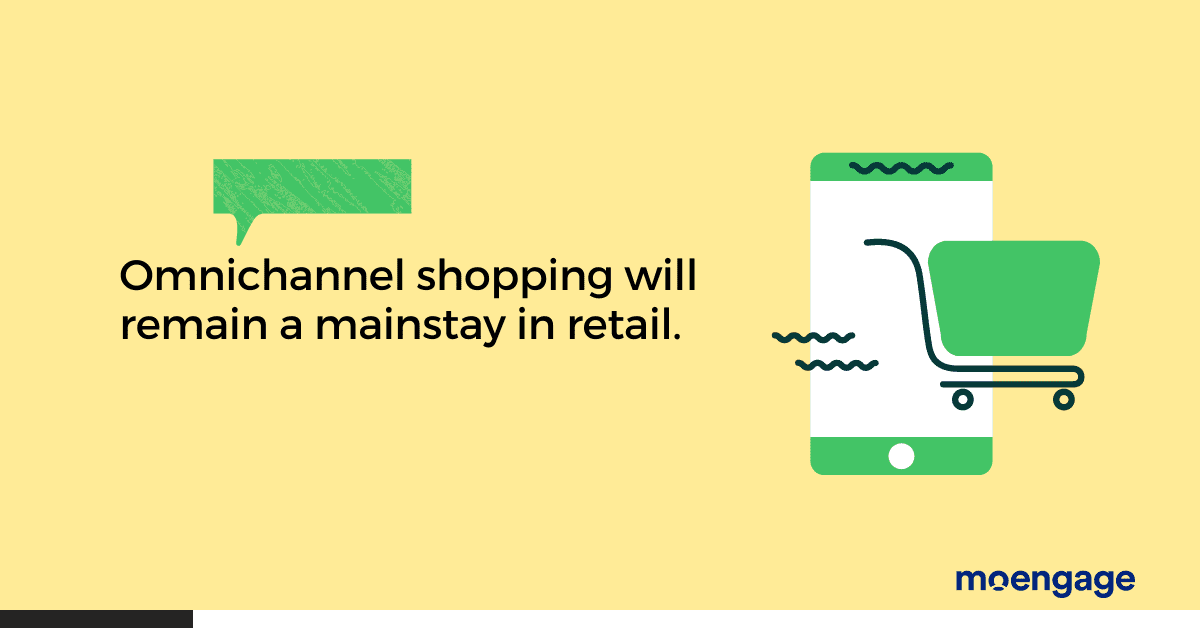
2022 and beyond will witness a complete change in the way customers behave and shop. As the world opens up again, convenience and interactive experience will be an addition to customer preferences, and needless to say, customers have and will start expecting a better omnichannel experience from retail brands.
Additionally, customers will not just shop online but explore multiple ways to connect with retail brands.
Another futuristic example of this can be the rise of the metaverse and retail brands positioning around it. Global retailers like Adidas, Burberry, Gucci, Tommy Hilfiger, Nike, and Louis Vuitton have bought space in the metaverse so that they can set up shop there.
The idea is to allow customers’ avatars to pop into a metaverse clothing shop and buy items to be sent in the real world.
The bottom line that remains is – as a retailer, to provide those personalized customer experiences, you must note the changes in shopping behavior and find ways to sharpen your strategy to meet the customer’s expectations.
Benefits of Hyper-Personalization in Retail
- Revenue and conversions increase: Personalization helps you engage your customers with the right message and experience. This increases the chances of conversions and thus maximizes your revenue.
- According to Boston Consulting Group’s (BCG) Personalization Maturity Index, retailers saw a 25% increase in revenue consistently due to their advanced personalization capabilities. A whopping 110% of customers said they were likely to add more items to their basket if the experience was personalized.
- Customer lifetime value improves: Deep-level personalization happens at all stages of the customer lifecycle. You can personalize your communication and the experience – from onboarding the customers to the time they check out and even after that. Ensure that all your channels are well integrated and there is continuity in the experience and communication with customers.
- Reduce customer churn: Personalization can help you overcome the much-touted debate around acquisition vs retention. Using hyper-personalization techniques, you can send targeted promotions to customers based on their purchase history and their time preference. This approach can help you build loyalty with better engagement and keep customers coming back.
- Net promoter scores increase: The BCG’s survey showed that customers who experienced a high level of personalization scored the retailer 20% higher on Net Promoter Score (NPS) than those who experienced a low level of personalization. As you might know, NPS is the north star metric to measure customer loyalty. A high score in NPS indicates that the customer is happy with the service and will likely recommend it to others.
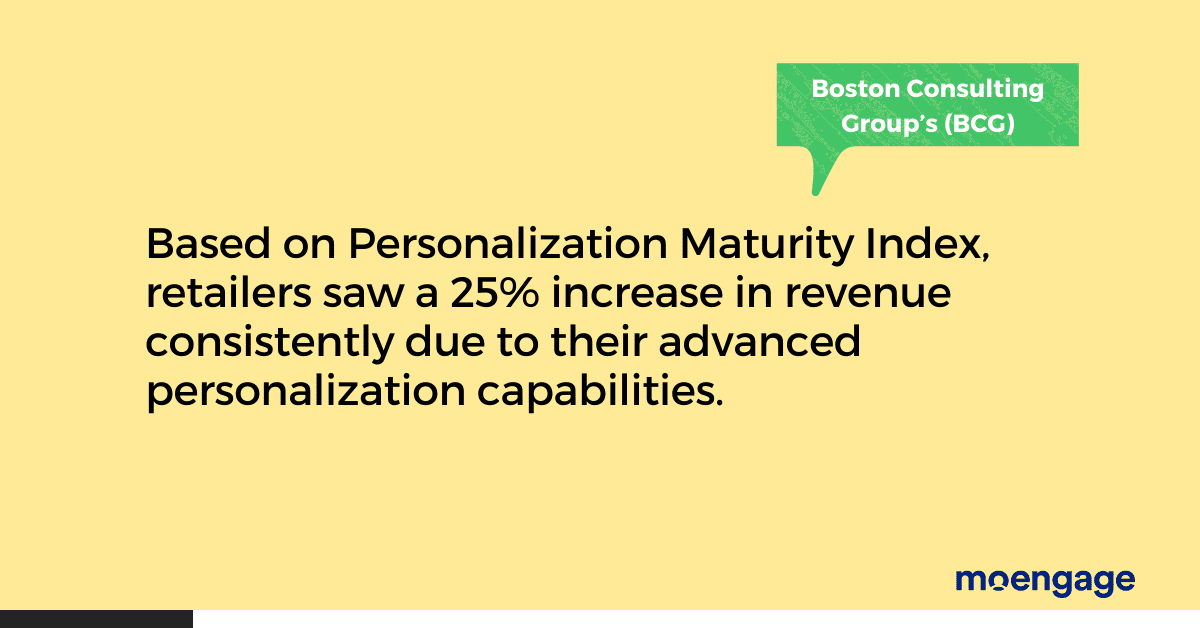
Important Statistics You Must Know About Personalization
Before we delve deeper into how you can deepen your personalization in retail strategy, let us look at some of the important trends from a customer point of view and how the marketers are responding to them
What Are the Customers Saying
In 2021, MoEngage surveyed 1,000 customers across the US, UK, Canada, and Germany to find out what challenges they face and what keeps them loyal to a brand. Here’s what we found:
General Personalization
- North Americans and Europeans cited customer experience and communication for customer delight. 26% of American and European customers expect B2C brands to personalize their experiences based on their shopping history.
- Inconsistent messaging, irrelevant product recommendations and too many or too few messages from the brands frustrate customers.
- Inconsistent messaging and irrelevant recommendations frustrate the C-level executives too. Over 30% of female C-executives revealed that they do not prefer receiving irrelevant content, while 41% of male executives expressed frustration with receiving inconsistent messages across different channels.
- The customers in administrative roles expressed too few or too many messages as a bone of contention.
- 30% of customers in North America and European countries preferred to receive promotional coupons and offers. Contrary to popular beliefs, customers did not express much interest in receiving newsletters, resources, or information about charity work and social justice.
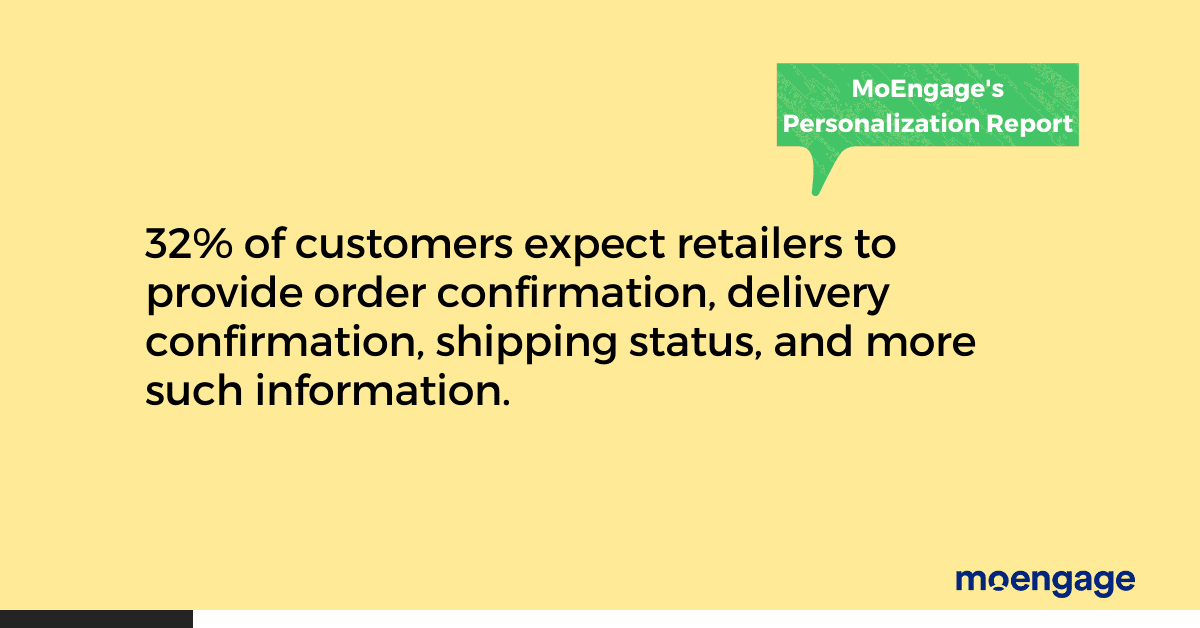
User-level Personalization
- What customers want is a value-added service. For example, 32% of customers expect retailers to provide order confirmation, delivery confirmation, shipping status, etc. 24% want a simplified process to return or exchange products at any point. Customers also want flexibility in how they place and pick up orders.
- While email continues to be the preferred channel for communication among North Americans and Europeans, SMS, social media, and social media messengers also continue to be a preferred medium for communication.
- 39% of North American and European customers expected weekly communication from brands when it comes to communication frequency. However, 41% of male C-level executives want daily updates from brands, while 33% of female C-level executives expect monthly updates.
- In personalization, 26% of customers expect brands to personalize their experience based on previous history and interests and 21% want it to be based on their interests.
- In the last 12 months, 36% of customers shopped more online than in person. 40% of them have said they will be taking a hybrid approach to shopping once normalcy restores.
You can find the full report here.
What Marketers Are Doing
In 2022, MoEngage surveyed 2,000 customers across the same geographies mentioned above (the US, UK, Canada, and Germany) to find out how marketers are responding to the pain points of customers, and here is what we found:
Insights Measured by Marketers
- In North America, 28% of retail brands draw insights from customer segment persona type categories closely followed by preferred channels and affinities
- However, in Europe, basic demographic information seems to dominate the marketer’s choice for insights. This is closely followed by affinities and probability to churn.
- If we double click on the Europe region, we find that in the UK and Germany, retail brands are using basic customer information, affinities, and probability to churn as the go-to for customer insights.
How Marketers are Personalizing Communication Using Customer Insights
- 25% of retail brands in North America and Europe are leveraging customer insights around preferred language, communication channels, and content affinity to personalize communication.
- The UK seems to be following the global cues, with ~28% of brands using customer insights around preferred language, communication channels, and content affinity to personalize communication.
- However, in Germany, 1 in 3 retail brands are using basic demographic insights to personalize communication. And almost 2 in 5 brands use information like customer segments, recency, and frequency to drive personalized communication and enhance brand loyalty.
What Customer Engagement Channels Are Brands Using to Communicate
- In terms of an omnichannel strategy, retail brands in North America and Europe chose emails as the first option. While basic personalization within emails has been present for a long time, brands are now looking toward hyper personalization to make emails more customer-centric.
- Apart from email as a channel, brands are also inclined towards SMS and in-app messaging.
- However, an interesting point to note here is – while social media as a channel may not be as prevalent as once mentioned above, it is picking pace and is becoming a preference for certain individual customers.
- A case in point – as per our research, in the UK and Germany, ~11% of marketers are using social media channels to communicate with customers.
Using WhatsApp as a channel to drive communication
Now that we know the trends that marketers are currently following and what customers are looking for let us look at ways that retail brands can enhance engagement using a hyper-personalization strategy.
The Three-Way Hyper-Personalization in Retail
Deep-level personalization in retail is all about creating micro-moments for your customers. Let’s look at the three-way approach you can use to personalize your customer’s experience.
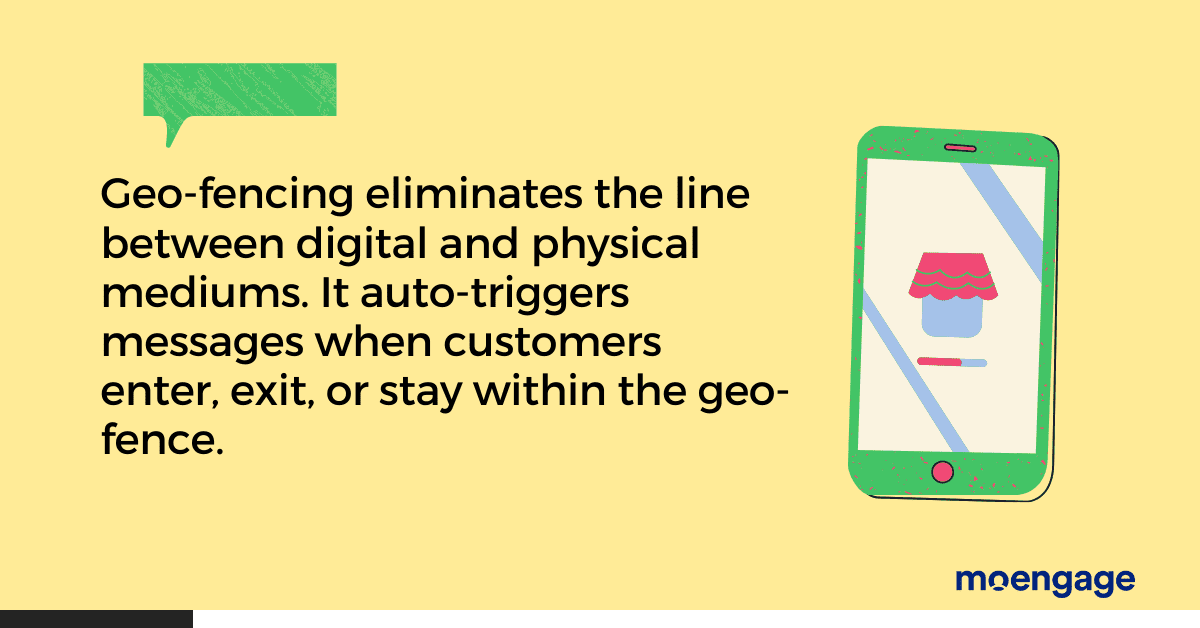
Optimize Targeting Using Geo-fencing
Imagine walking into a mall to meet your friend and suddenly receiving a message from your favorite fashion retailer about a sale going on in the outlet at the same mall. Sounds intriguing, right? How did they know that you are in the same location? Retailers have started using GPS-based geo-fencing technology to target customers. Geo-fencing is different from geo-targeting. It works on a more micro level. Retailers can define a range around their location. So, anytime the customer comes close to your defined location, they will automatically receive a notification about your presence. Geo-fencing helps increase the footfall in your stores and even target your competitor’s customers in the exact location as yours.
How You Can Achieve This Using MoEngage:MoEngage’s Geo-fencing solution eliminates the line between digital and physical mediums. It auto-triggers messages when customers enter, exit, or stay within the geo-fence. It enables you to deliver real-time and relevant messages and drive better engagement at physical touchpoints. Geo-fencing has enabled brands to increase their customer retention to up to 30%. |
Optimize Messaging Using AI
As we observed in our research, customers want brands to send relevant messages to them. They disengage as soon as the brand sends them irrelevant messages. So, what can you do to optimize your messaging? You can use AI. AI ensures that your messaging is personalized and relevant, but not to the extent that it creeps the customer. AI will eliminate all the guesswork and inform you exactly what kind of message will resonate the most with your customer. This will help you to personalize your message and build engagement with your customer.
How You Can Achieve This Using MoEngage:MoEngage’s proprietary AI engine Sherpa removes all the guesswork and automatically figures out the right message variant and the right time to send a message to customers. Sherpa analyzes the performance of different message variations and automatically picks the top-performing content to be shown to customers in real-time. It also picks the right moment to deliver it. |
Optimize Engagement Using Personalization
Customer engagement is more difficult than acquiring a new one. Hence, focus on optimizing your engagement across different channels and at every level of the customer’s lifecycle. Ensure that the messaging and experience are consistent and seamless across all channels. Leverage customer data to provide personalized recommendations. This will help you to deepen your engagement with the customers.
How You Can Achieve This Using MoEngage:MoEngage’s Flows is the perfect solution for you to: Segment customers, map journeys, and delight them with personalized communication across the web, email, and mobile! You can also auto-segment customers based on their behavior and create cross-channel lifecycle campaigns to communicate and engage with them at every stage of the lifecycle. |
Retail will be a $27 trillion market by 2022. As customer demands evolve and new players enter the industry, you need to strengthen your personalization in retail strategies and engage your customers continuously across all channels.
What To Do next?
- Read how brands are moving from first-name-level personalization to event-based and customer-based personalization here.
- Learn how you can create a hyper-personalized shopping experience across the customer journey using MoEngage and Shopify in our recent blog here.
- Do you want to learn how to hyper-personalize your campaigns? Check out this blog for real-world examples and inspiration.
- Curious to know how to use AI for your campaigns? Read this blog.
- To learn more about our products and for a free demo, visit our website.









